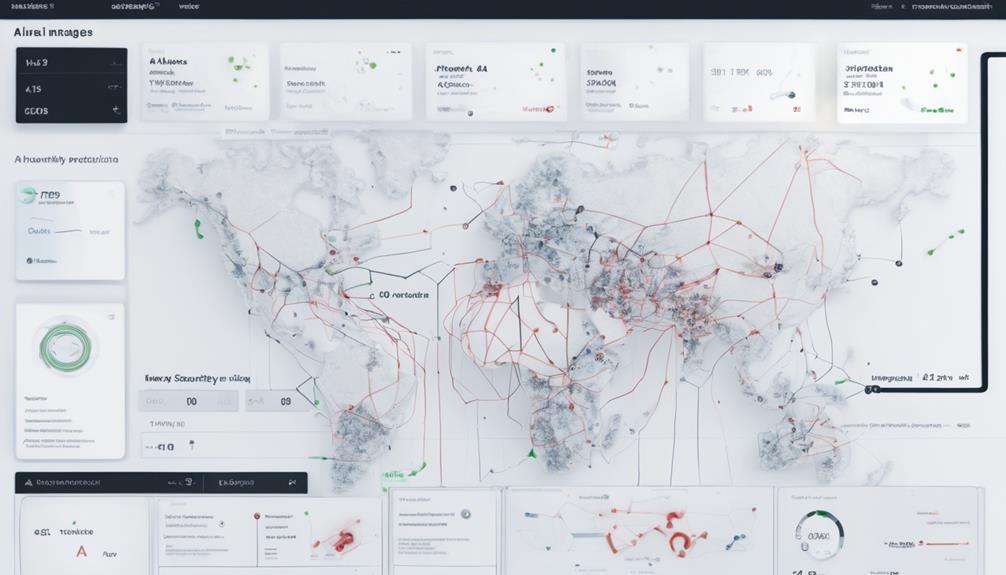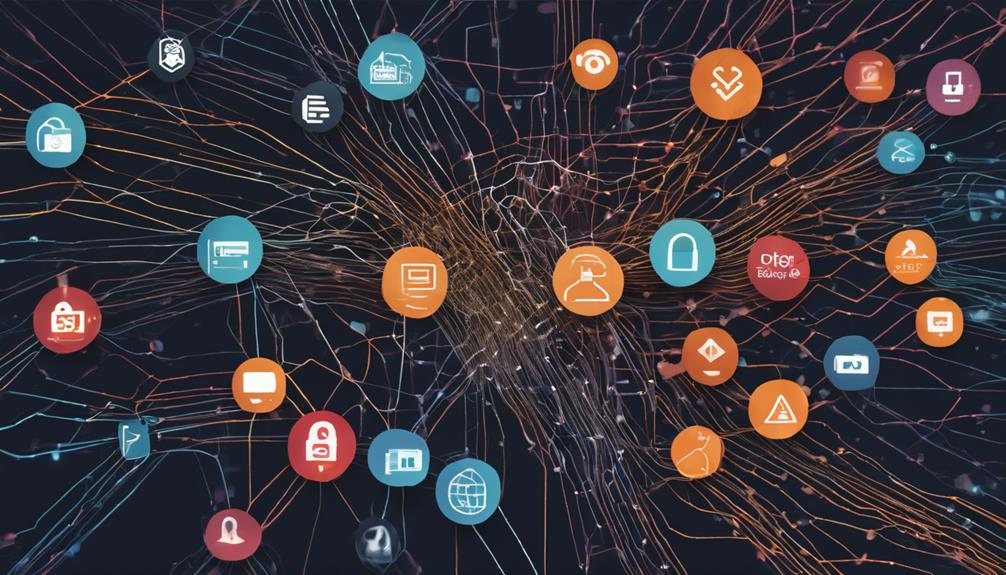Within cybersecurity, AI's main use case is amping up threat detection agility to counter ever-evolving cyber risks. By automating threat intelligence, swiftly spotting real-time menaces, and boosting data analysis for anomaly detection, AI fortifies defenses efficiently. It optimizes threat prioritization, adapts through continual learning, and accelerates response times noticeably, all while enhancing threat assessment with predictive risk analysis. Strengthened defenses, especially against emerging risks, round out AI's pivotal role in fortifying cybersecurity. Mastering AI's prowess in these areas can decisively shield against modern cyber threats.
Key Takeaways
- Threat Intelligence Automation revolutionizes threat detection and response in cybersecurity.
- Real-time Threat Detection swiftly identifies and responds to potential risks using AI.
- Data Analysis Enhancement improves threat detection with advanced anomaly detection.
- Prioritization Optimization maximizes security resource effectiveness through automated incident response.
- Continuous Learning and Adaptation enhances security measures by staying ahead of evolving threats.
Threat Intelligence Automation
Threat intelligence automation through the integration of AI technologies has revolutionized the way organizations detect and respond to emerging cybersecurity risks. By leveraging AI in security operations, organizations can enhance their threat assessment capabilities through real-time analysis of cyber threats.
AI-powered tools efficiently process vast amounts of security data from diverse sources, greatly improving the accuracy of threat assessments. This automation enables security teams to prioritize and respond to critical threats promptly, leading to more effective risk mitigation strategies. Additionally, AI-driven threat intelligence solutions empower organizations to adopt proactive defense measures by promptly alerting them to potential cyber threats.
Incorporating AI into threat intelligence not only streamlines security operations but also provides valuable insights for organizations to bolster their defenses against evolving cyber threats. Embracing AI technology in threat intelligence automation is key to staying ahead of cyber adversaries and ensuring a robust cybersecurity posture in today's dynamic threat landscape.
Real-time Threat Detection

AI's prowess in cybersecurity is exemplified through its ability to swiftly detect real-time threats by efficiently analyzing diverse data sources. Machine learning algorithms play an essential role in this process by identifying unusual user behavior patterns that could indicate potential cyberattacks. AI applications encompass various vital tasks such as malware detection, security log analysis, and maintaining endpoint security.
Moreover, advanced authentication techniques are employed to enhance user account security and password protection. By utilizing anomaly detection, AI-driven cybersecurity measures establish benchmarks for typical user behavior, enabling the prompt identification of any deviations that may signal a security threat. This proactive approach to real-time threat detection allows for immediate responses to potential risks, safeguarding systems and data effectively.
Essentially, AI's ability to continuously monitor, analyze, and adapt to evolving cybersecurity challenges significantly strengthens overall defense mechanisms against malicious activities.
Data Analysis Enhancement

Enhancing data analysis in cybersecurity through AI offers notable advantages such as improved threat detection, enhanced anomaly identification, and predictive risk analysis.
Improved Threat Detection
Utilizing advanced data analysis techniques, artificial intelligence greatly enhances the capability of cybersecurity systems to detect and mitigate potential risks. AI in cybersecurity leverages machine learning algorithms to analyze data from various sources, including hidden ones like videos and emails, enabling more extensive threat detection. By monitoring user behavior, AI can identify anomalies that may indicate cyber threats, allowing for proactive intervention before damage occurs. Real-time prevention is a key feature of AI-powered cybersecurity, ensuring swift responses to emerging threats without disrupting normal operations. This proactive approach to threat detection sets AI apart in the cybersecurity domain, enabling organizations to stay ahead of cybercriminals. Below is a table highlighting the key components of AI-enhanced threat detection:
| AI in Cybersecurity Features | |
|---|---|
| Threat Detection | Machine Learning |
| Analyze Data | User Behavior |
| Anomalies | Real-time Prevention |
| Data Sources | Hidden Data Sources |
Enhanced Anomaly Detection
Enhanced anomaly detection in cybersecurity through advanced data analysis techniques plays a pivotal role in bolstering defense mechanisms against potential cyber threats. Leveraging AI-powered anomaly detection and machine learning algorithms, cybersecurity measures are greatly strengthened.
Reducing False Positives: AI systems can sift through massive amounts of data to differentiate between normal and abnormal activities, minimizing false alerts that can overwhelm security teams.
Early Detection of Security Incidents: By continuously monitoring network behavior, AI can swiftly identify potential breaches or security incidents, enabling proactive responses to mitigate risks.
Improving Cybersecurity Posture: Through real-time insights into abnormal activities, AI-powered anomaly detection enhances the overall cybersecurity posture of organizations, fortifying defenses against evolving threats.
Enhancing Efficiency for Security Teams: By prioritizing alerts and providing actionable insights, AI streamlines the workflow for security teams, allowing them to focus on critical tasks more effectively.
Predictive Risk Analysis
Predictive risk analysis in cybersecurity harnesses AI capabilities to proactively anticipate and mitigate potential cyber threats. By leveraging historical data, AI-driven predictive risk analysis can identify patterns and trends to predict future cyber threats, enabling organizations to prioritize security measures effectively. This approach empowers proactive defense strategies by preemptively addressing security risks before they materialize, ultimately minimizing security breaches and strengthening overall cybersecurity defenses.
AI's role in predictive risk analysis is pivotal in enhancing data analysis capabilities to forecast and prevent cyber incidents. By utilizing AI algorithms to analyze vast amounts of data, organizations can stay ahead of evolving threats and tailor their security responses accordingly. This proactive approach not only helps in preventing potential cybersecurity breaches but also enables a more strategic allocation of resources to bolster cybersecurity defenses.
Embracing predictive risk analysis powered by AI is essential in the ever-evolving landscape of cybersecurity to stay one step ahead of malicious actors.
Prioritization Optimization

The optimization of threat prioritization in cybersecurity through AI involves analyzing vast amounts of data to identify critical security risks. This process is essential for security teams to effectively manage their resources and respond promptly to potential threats.
Here's how AI-driven prioritization optimization enhances cybersecurity:
- Focus on High-Priority Vulnerabilities: Machine learning algorithms help pinpoint high-priority vulnerabilities, allowing security teams to prioritize their response efforts efficiently.
- Automated Incident Response: AI automates the identification and resolution of security threats, streamlining incident response processes and reducing manual workload.
- Prioritization of Security Alerts: AI tools prioritize security alerts based on risk levels, enabling quicker responses and improving overall security posture.
- Efficient Resource Allocation: By optimizing threat prioritization, AI maximizes the effectiveness of security resources, minimizing the potential impact of security incidents.
Continuous Learning and Adaptation

Continuous learning and adaptation in cybersecurity leverage AI's ability to evolve and refine threat detection mechanisms over time. By continuously analyzing large datasets, machine learning algorithms can adapt to new cyber threats, enhancing security measures and reducing the time needed to detect and respond to security issues.
This proactive approach enables AI to predict potential attacks by evaluating billions of security signals, ultimately improving threat detection accuracy.
Through continuous learning, AI can stay ahead of evolving cyber threats, learning from past incidents to strengthen future defenses. This adaptive capability empowers AI to detect and prevent malware and cyber threats efficiently, safeguarding systems and data from potential breaches.
As technology advances and cyber threats become more sophisticated, the integration of continuous learning and adaptation into cybersecurity practices is essential for maintaining a robust defense posture against evolving threats.
Accelerated Response Times

Enhancing incident response efficiency, AI in cybersecurity automates and accelerates threat containment processes. This results in accelerated response times and improved overall cybersecurity posture.
Here are key aspects highlighting the benefits of AI in accelerating response times:
- Real-Time Threat Detection: Machine learning algorithms enable the immediate identification of potential threats, reducing the time to identify security breaches.
- Instant Alerts and Responses: AI-driven security systems provide instant alerts and responses to security incidents, facilitating rapid containment measures and mitigating the impact of breaches.
- Automated Incident Response: By automating incident responses, AI minimizes the manual intervention required, allowing for swift and effective handling of cybersecurity incidents.
- Rapid Identification and Response: AI's capability to process large volumes of data quickly enables rapid identification and response to cyber threats, ensuring timely action to minimize security risks.
Improved Threat Assessment

Enhancing threat assessment in cybersecurity involves leveraging AI to detect patterns and anomalies, ultimately improving detection accuracy.
Real-time monitoring capabilities enabled by AI-driven systems offer swift alerts and responses to security incidents, reducing response times and bolstering overall cybersecurity defenses.
Threat Detection Accuracy
Substantially strengthening cybersecurity defenses, the utilization of AI enhances threat detection accuracy through real-time analysis of vast data sets. Machine learning algorithms play an essential role in this process by evaluating billions of security signals to predict potential attack pathways.
For instance, Microsoft's Cyber Signals program exemplifies this capability by processing a staggering 24 trillion security signals daily, leveraging AI for enhanced threat intelligence. The proactive approach of AI aids in the timely detection and prevention of malware and cyber attacks, effectively safeguarding systems before any harm occurs.
Additionally, AI's ability to efficiently identify new malware strains ensures the conservation of resources and the prevention of potential intrusions. By harnessing the power of AI for threat detection accuracy, organizations can stay ahead of evolving cyber threats and bolster their overall cybersecurity posture.
Real-Time Monitoring Capabilities
AI's role in cybersecurity extends to providing real-time monitoring capabilities that greatly enhance threat assessment processes. By utilizing sophisticated machine learning algorithms, AI-driven systems can analyze vast amounts of data in real-time, enabling immediate threat detection and instant alerts in the event of security incidents. This proactive approach allows organizations to fortify their cybersecurity posture by swiftly responding to evolving cyber threats.
Real-time monitoring not only facilitates the rapid identification of potential risks but also empowers teams to take proactive defense measures before significant damage occurs. The ability to receive instant alerts about suspicious activities or anomalies enables security professionals to investigate and mitigate threats promptly, ultimately strengthening the overall resilience of the system.
In today's landscape of sophisticated cyber threats, the importance of real-time monitoring cannot be overstated. By leveraging AI capabilities for instantaneous threat assessment and response, organizations can stay one step ahead of malicious actors and safeguard their digital assets effectively.
Strengthened Cybersecurity Defenses

By bolstering security measures, artificial intelligence plays a pivotal role in fortifying cybersecurity defenses against evolving threats. Here are four ways AI strengthens cybersecurity defenses:
- Enhanced Threat Detection: AI algorithms and machine learning enable more accurate and rapid identification of potential cyber threats, reducing the chances of successful attacks.
- Improved Incident Response Times: By automating incident responses, AI helps security teams react swiftly to security breaches, minimizing the impact and mitigating potential damages.
- Vital Defense with Predictive Analytics: AI empowers proactive defense strategies by using predictive analytics to anticipate and prevent cyber threats before they materialize.
- Utilization of Varied Data Sources: Integrating diverse data sources, AI can handle the complexity of modern cyber threats effectively, providing detailed insights for better decision-making.
Security teams benefit from reduced workloads as AI automates tasks, enhancing overall cybersecurity efficiency.
AI's role in fortifying cybersecurity defenses is essential in today's ever-evolving threat landscape.
Emerging Risk Identification

Artificial intelligence in cybersecurity demonstrates remarkable proficiency in identifying emerging risks through real-time analysis of extensive data sets. Machine learning algorithms play an essential role in predicting potential attack pathways by evaluating billions of security signals.
AI-powered threat intelligence tools provide real-time data analysis from multiple sources, enabling accurate risk assessment and automated threat detection. By automating the collection of data on emerging risks, AI enhances threat detection capabilities, enabling organizations to stay ahead of cyber threats.
Additionally, AI applications in cybersecurity engage in continuous learning and adaptation, refining their algorithms to improve the accuracy of identifying new cyber threats. This proactive approach to emerging risk identification empowers organizations to bolster their cybersecurity defenses effectively and respond promptly to evolving threats in the digital landscape.
Frequently Asked Questions
What Is the Main AI Use Case in Cybersecurity?
In the field of cybersecurity, AI plays a pivotal role by leveraging advanced algorithms to detect and prevent potential threats. By analyzing vast data sets and identifying anomalous patterns, AI enhances security measures and fortifies defenses against cyberattacks.
How Is AI Being Used in Cyber Attacks?
In the ever-evolving landscape of cybersecurity, AI is harnessed by cyber attackers to orchestrate intricate assaults, exploit vulnerabilities with precision, and craft customized phishing schemes. To counter these sophisticated threats, organizations must fortify their AI-driven defense strategies.
What Are Use Cases in Cyber Security?
In the field of cybersecurity, various use cases for AI have emerged, including threat detection, incident response automation, predictive analytics for proactive defense, malware detection, phishing scam identification, security log analysis, network monitoring, and user behavior tracking.
What Is AI Used for in Security?
Within the domain of security, AI serves as a strategic ally in enhancing threat detection capabilities, improving response time, and alleviating the burden on security teams. Its proactive nature aids in fortifying defenses and safeguarding against potential risks.
Conclusion
To sum up, the main AI use case in cybersecurity is like a vigilant guardian, constantly monitoring and analyzing data to detect and respond to threats in real-time.
By automating threat intelligence, enhancing data analysis, and optimizing prioritization, AI strengthens cybersecurity defenses and improves response times.
With continuous learning and adaptation, AI helps identify emerging risks and enhances threat assessment.
Embrace the power of AI in cybersecurity to stay ahead of cyber threats and protect your digital assets effectively.









